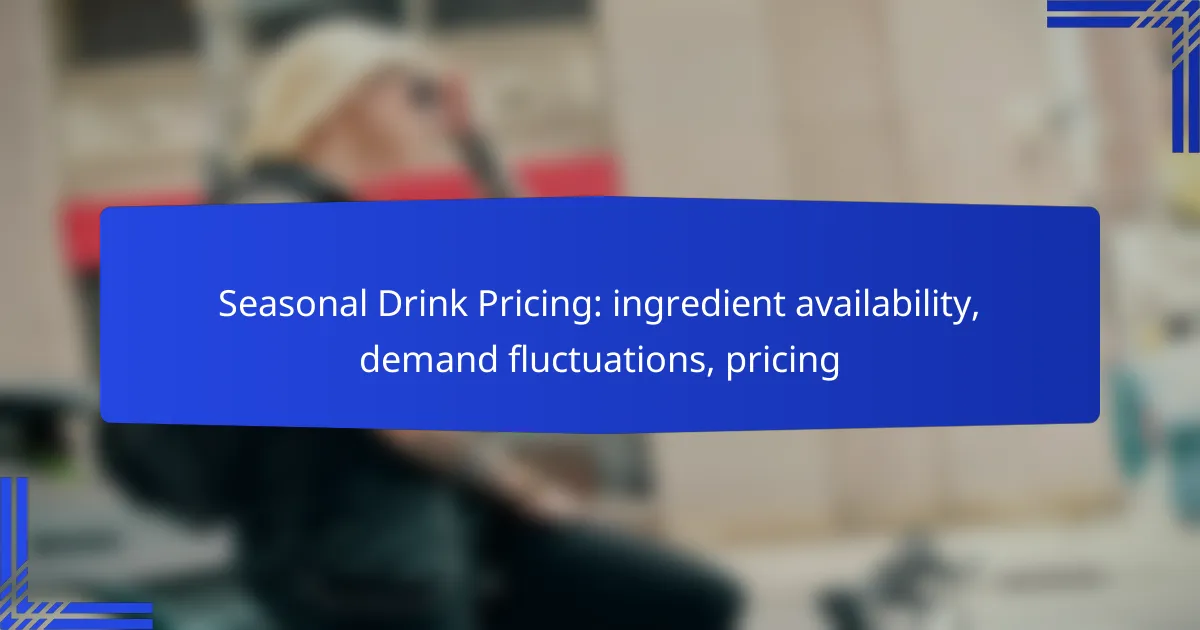Seasonal drink pricing is intricately linked to ingredient availability and demand fluctuations, particularly in Australia. As certain ingredients become scarce, prices can rise, directly affecting the cost of these beverages. Additionally, factors such as holidays, weather changes, and shifting consumer preferences play a crucial role in demand, prompting businesses to adapt their pricing strategies to optimize profits while meeting customer needs.

How does ingredient availability affect seasonal drink pricing in Australia?
Ingredient availability significantly influences seasonal drink pricing in Australia due to fluctuations in supply and demand. When certain ingredients are scarce, prices tend to rise, impacting the overall cost of seasonal beverages.
Impact of local harvests
Local harvests play a crucial role in determining the availability of ingredients for seasonal drinks. When harvests are abundant, prices can remain stable or even decrease, making drinks more affordable. Conversely, poor harvests due to weather conditions or pests can lead to shortages, driving prices up.
For example, if a particular fruit is in season and plentiful, cafes and bars can offer drinks featuring that fruit at lower prices. However, if a drought affects the harvest, prices may increase significantly, impacting consumer choices.
Supply chain disruptions
Supply chain disruptions can severely affect ingredient availability, leading to increased prices for seasonal drinks. Factors such as transportation issues, labor shortages, or global events can hinder the timely delivery of essential ingredients.
For instance, if a key ingredient is imported and shipping delays occur, local businesses may face higher costs, which they often pass on to consumers. This can result in seasonal drinks becoming more expensive, even if the local harvest is adequate.
Seasonal crop yields
The yield of seasonal crops directly impacts the availability of ingredients for drinks. High yields typically lead to lower prices, while low yields can create scarcity and drive prices higher. Seasonal variations, such as unexpected frosts or floods, can drastically affect crop yields.
In Australia, the yield of crops like citrus fruits can vary significantly from year to year, influencing the pricing of drinks that feature these ingredients. Businesses must monitor crop forecasts to adjust their pricing strategies accordingly.
Import/export regulations
Import and export regulations can affect the availability and pricing of seasonal drink ingredients in Australia. Stricter regulations may limit the import of certain ingredients, leading to shortages and increased prices.
For example, if new tariffs are imposed on imported spices or fruits, local businesses may need to raise prices to maintain profit margins. Understanding these regulations is essential for businesses to navigate pricing strategies effectively and ensure ingredient availability.

What are the demand fluctuations for seasonal drinks?
Demand fluctuations for seasonal drinks are influenced by various factors, including holidays, weather changes, and evolving consumer preferences. Understanding these fluctuations can help businesses optimize pricing and inventory management.
Peak holiday seasons
During peak holiday seasons, such as Christmas and Halloween, demand for seasonal drinks often surges. For instance, pumpkin spice lattes see a spike in popularity in the fall, while eggnog becomes a staple in winter. Businesses should prepare for increased demand by adjusting their inventory and pricing strategies accordingly.
Pricing may also reflect this heightened demand, with some drinks priced higher during these peak times. Offering limited-time promotions can attract customers while managing inventory effectively.
Weather influences
Weather significantly impacts the demand for seasonal drinks. For example, warm weather can boost sales of iced beverages, while colder temperatures increase the popularity of hot drinks. Businesses should monitor weather forecasts to anticipate changes in consumer preferences and adjust their offerings accordingly.
In regions with distinct seasons, such as the U.S. Northeast, this can mean a shift from refreshing summer drinks to cozy winter options. Pricing strategies may need to adapt based on these seasonal shifts to maximize sales.
Consumer trends
Consumer trends play a crucial role in shaping demand for seasonal drinks. Health-conscious consumers may prefer lighter, lower-calorie options, while others might seek indulgent flavors during festive seasons. Keeping an eye on these trends can help businesses tailor their seasonal offerings to meet customer expectations.
Additionally, social media influences can drive demand for trendy drinks, making it essential for brands to stay updated on popular flavors and ingredients. Engaging with customers through promotions or limited-time offerings can capitalize on these trends effectively.

How do pricing strategies vary for seasonal drinks?
Pricing strategies for seasonal drinks often fluctuate based on ingredient availability, demand, and market trends. Businesses may adopt various approaches to optimize profits while attracting customers during peak seasons.
Dynamic pricing models
Dynamic pricing models adjust prices based on real-time factors such as demand, supply chain costs, and competitor pricing. For instance, a coffee shop might increase prices for pumpkin spice lattes during peak autumn months when demand surges. This strategy can maximize revenue but may deter price-sensitive customers.
To implement dynamic pricing effectively, businesses should monitor sales data and customer behavior closely. A common approach is to use software that analyzes trends and automatically adjusts prices accordingly.
Promotional discounts
Promotional discounts are often used to entice customers to try seasonal drinks, especially when introducing new flavors. For example, a café might offer a “buy one, get one free” deal on holiday-themed beverages to boost sales during the festive season. These discounts can help clear inventory and attract foot traffic.
However, businesses should ensure that discounts do not erode profit margins excessively. Setting clear limits on the promotion duration and quantity can help maintain profitability while still appealing to customers.
Bundling offers
Bundling offers combine seasonal drinks with complementary items, such as pastries or snacks, at a discounted price. This strategy encourages customers to purchase more while enhancing their overall experience. For example, a tea shop might offer a seasonal chai latte with a cookie for a set price, providing perceived value.
When creating bundling offers, consider the cost of ingredients and the overall appeal of the combination. It’s essential to ensure that the bundled price remains attractive while still covering costs and generating profit.

What are the key factors influencing seasonal drink pricing?
Seasonal drink pricing is primarily influenced by ingredient availability, market competition, and consumer preferences. These factors can lead to fluctuations in costs and pricing strategies throughout the year.
Ingredient costs
Ingredient costs play a crucial role in determining the price of seasonal drinks. When certain ingredients are in high demand or limited supply, their prices can increase significantly. For example, pumpkin spice flavors may see a spike in cost during fall due to high demand and limited harvests.
It’s important for businesses to monitor ingredient prices closely and adjust their pricing accordingly. Establishing relationships with suppliers can help secure better rates, especially during peak seasons.
Market competition
Market competition can greatly affect seasonal drink pricing as businesses strive to attract customers. If multiple establishments offer similar seasonal drinks, they may lower prices to remain competitive. This can lead to a price war, which may benefit consumers but can hurt profit margins for businesses.
To navigate this, businesses should consider unique offerings or limited-time promotions that differentiate their drinks from competitors. Highlighting unique ingredients or preparation methods can justify higher prices.
Consumer preferences
Consumer preferences significantly influence seasonal drink pricing. Trends in health, flavor, and sustainability can shift demand, impacting how much customers are willing to pay. For instance, drinks made with organic or locally sourced ingredients may command higher prices due to their perceived value.
Understanding target demographics and their preferences can guide pricing strategies. Conducting surveys or monitoring social media trends can provide insights into what consumers are looking for, allowing businesses to adjust their offerings and pricing accordingly.

How can businesses optimize pricing for seasonal drinks?
Businesses can optimize pricing for seasonal drinks by analyzing ingredient availability, monitoring demand fluctuations, and adjusting prices accordingly. This approach helps maximize profit margins while remaining competitive in the market.
Data-driven pricing analysis
Data-driven pricing analysis involves collecting and analyzing sales data, ingredient costs, and market trends to inform pricing strategies. Businesses should track historical sales patterns during previous seasons to identify peak demand periods and adjust prices to match consumer behavior.
Utilizing tools like point-of-sale systems and inventory management software can provide insights into which seasonal drinks are most popular and how pricing changes affect sales volume. For instance, if a particular drink sells significantly more during a holiday season, businesses can consider raising prices slightly during that period to capitalize on increased demand.
Customer feedback integration
Integrating customer feedback into pricing strategies can enhance the appeal of seasonal drinks. Gathering insights through surveys, social media interactions, and direct customer comments helps businesses understand consumer preferences and price sensitivity.
For example, if customers express a willingness to pay more for premium ingredients in seasonal drinks, businesses can adjust their pricing to reflect this value. Regularly reviewing feedback allows for timely adjustments, ensuring that pricing remains aligned with customer expectations.
Flexible pricing strategies
Implementing flexible pricing strategies allows businesses to adapt quickly to changes in ingredient availability and consumer demand. Seasonal drinks can be priced dynamically based on factors such as weather conditions, local events, or competitor pricing.
For instance, during a particularly hot summer, a coffee shop might lower prices on iced beverages to attract more customers, while raising prices during cooler months when demand for hot drinks increases. This adaptability can help maintain sales throughout the season and optimize profit margins.
